An onboarding program is essential when new hires join a new company. Yet many organizations have discovered that these initiatives fail to meet expectations. If you know the reasons, you can create the right onboarding experience that will be effective and efficient.
Common Pitfalls in Onboarding
Lack of Structure
An effective onboarding program eliminates confusion and ensures new hires receive the guidance they need. A lack of structure overwhelms employees, resulting in disengagement and early turnover. A well-designed onboarding program provides clear direction, introduces company culture, and delivers essential information systematically.
Overloading Information
Another issue is overwhelming newcomers with too much information. Overwhelming them with minor details can turn them conspiratorial and cause disinterest. Information must be dribbled out gradually to combat this, allowing people enough time to digest the various morsels.
Failure to Personalize
One-size-fits-all onboarding programs do not focus on the specific needs of different roles. Tailoring the program to other roles or ways people like to learn can enormously boost employee engagement and retention. Customizing the content adds more relevance and value to the process.
Inadequate Support
When new hires do not receive enough support, they can fall victim to the challenges they face. Employees cannot simply slip into a role the same way a system button would if it were activated by pushing the button a second time on a keyboard if no one offers to guide or assist new vultures in their positions or provide any kind of peek at the inner workings. Social circles create a feeling of community and promote an effortless transition.
Ignoring Feedback
Not gathering and acting on feedback will result in a lack of optimal onboarding practices. Feedback from recent hires helps modify and improve upcoming experiences. This system fosters a culture of continuous improvement that helps newcomers and dramatically benefits them.
Strategies for Improvement
Develop a Comprehensive Plan
A carefully crafted plan acts as a roadmap for onboarding. This process includes defining the goals, identifying the significant milestones, and clarifying the parties’ responsibilities-led plan, which provides consistency and keeps you focused.
Implement Phased Learning
Phased learning splits the onboarding journey into bite-sized phases. Breaking news can help employees understand and remember the key messages better. This method promotes gradual advancement and minimizes the potential for inundating newcomers.
Customize Programs
Known for its onboarding experiences, customization in the onboarding experience adds immense value. Customizing content to role and personal needs enables a more personalized journey.
This type of customization recognizes that not all learners prefer the same way of learning, nor do they necessarily require the same knowledge base in their jobs.
Establish Support Systems
Having support systems in place is essential for an effective transition. Develop mentorship programs and peer networks and establish clear communication channels to help new hires feel appreciated and connected. Such activities can also facilitate a smoother integration of a positive working environment.
Include Bidirectional Feedback Processes
You can only incorporate feedback mechanisms into onboarding and continue to fine-tune them. Frequent surveys, feedback sessions, and open communication channels motivate new employees to give genuine feedback. Organizations can work to improve their programs continuously by listening and responding to this feedback.
Measuring Success
Setting Metrics
The foundation of any onboarding program’s success is its measurement and metrics. Some may include how long employees stay, how long it takes a worker to become proficient, and engagement levels. Organizations can track these indicators to measure the success of their efforts and learn how to improve.
Analyzing Data
Examining trends and patterns can expose strengths and weaknesses and ultimately inform future improvements. Making data-driven decisions will allow programs to evolve in tandem with organizational goals and employee needs.
Continuous Improvement
Onboarding should be an ongoing process, not a one-time event. With the constant urge to do better, organizations will be able to adapt shifts and polish their methods. This continued effort will provide an even better onboarding experience for new hires.
Conclusion
Comprehensive onboarding programs are essential on the road to success for new employees. Organizations can take five steps to avoid these pitfalls and evolve their strategy for creating experiences of more lasting value.
This structured, customized, and supportive transition positively impacts the employees and the organization. Feedback and constant improvement are key to keeping onboarding relevant and thriving in a constantly changing workplace.


